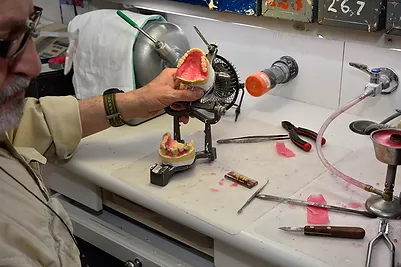Creating a perfect denture involves a series of precise steps, ensuring the final product is comfortable, functional, and aesthetically pleasing. Here is a detailed overview of the process:
1. Initial Consultation and Examination
Patient Evaluation: The dentist conducts a comprehensive oral examination, including assessing the patient’s oral tissues, bone structure, and any remaining teeth.
Medical History: Reviewing the patient’s medical history and discussing their dental concerns, preferences, and expectations.
Preliminary Impressions: Taking preliminary impressions of the patient’s mouth using dental impression material to create study models.
2. Treatment Planning
Diagnosis and Planning: Based on the examination and study models, the dentist formulates a treatment plan, discussing it with the patient.
Type of Denture: Deciding whether a complete denture (for patients with no teeth) or a partial denture (for patients with some remaining teeth) is needed.
Material Selection: Choosing appropriate materials for the denture base and teeth, considering durability, aesthetics, and patient comfort.
3. Primary Impressions and Custom Tray Fabrication
Primary Impressions: Taking more detailed impressions of the patient’s oral tissues using high-quality impression material.
Custom Tray Creation: The dental laboratory uses these impressions to fabricate custom trays that fit the patient’s mouth precisely, allowing for more accurate final impressions.
4. Final Impressions
Border Molding: Using a special material to mold the edges of the custom tray, ensuring an accurate fit around the periphery of the denture.
Final Impressions: Taking the final impressions with the custom trays, capturing the exact shape and contours of the oral tissues and ridges.
5. Bite Registration
Recording Jaw Relations: Using wax rims or other materials, the dentist records the patient’s bite and jaw relationships, including the vertical dimension of occlusion (VDO) and centric relation.
Facebow Transfer: In some cases, a facebow transfer is performed to accurately relate the upper jaw to the skull.
6. Teeth Selection and Setup
Teeth Selection: Choosing the shape, size, and color of the artificial teeth to match the patient’s natural teeth and facial aesthetics.
Wax Try-In: The selected teeth are set in wax on the denture base, allowing the dentist and patient to visualize the denture’s appearance and function before final processing.
7. Try-In Appointment
Wax Denture Fitting: The wax denture is tried in the patient’s mouth to check the fit, bite, aesthetics, and phonetics.
Adjustments: Any necessary adjustments are made to the wax setup based on patient feedback and clinical observations.
8. Processing the Denture
Final Processing: The wax denture is sent back to the dental laboratory for final processing. The wax is replaced with acrylic resin through a process called flasking and investing.
Curing: The resin is cured to create a hard, durable denture base.
Finishing and Polishing: The denture is carefully finished and polished to ensure a smooth, comfortable surface.
9. Delivery and Fitting
Final Fitting: The completed denture is placed in the patient’s mouth, and the dentist checks the fit, occlusion, and aesthetics.
Adjustments: Minor adjustments are made to ensure optimal comfort and function.
10. Post-Delivery Care and Follow-Up
Patient Instructions: Providing the patient with detailed instructions on how to care for their new dentures, including cleaning and maintenance tips.
Follow-Up Appointments: Scheduling follow-up visits to monitor the fit and function of the dentures, making any necessary adjustments to address sore spots or discomfort.
Conclusion
Creating a perfect denture is a meticulous process that requires collaboration between the dentist, dental technician, and patient. By following these detailed steps, dental professionals can ensure that the final denture provides the best possible fit, function, and aesthetics, ultimately enhancing the patient’s oral health and quality of life.





